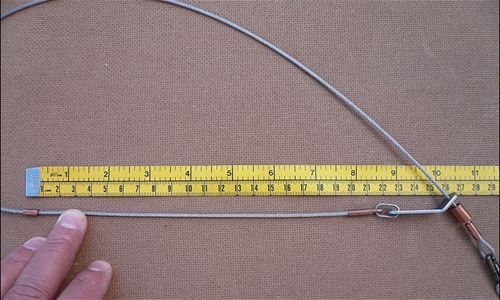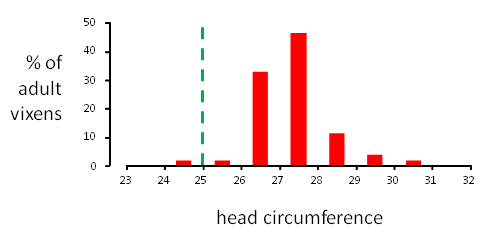The intention of a minimum loop size is (a) to allow the easy escape of non-target animals (e.g. deer which step into the snare noose); (b) to prevent strangulation of animals caught by the neck. Although the use of snares is ultimately a way of catching animals for lethal control, snares in the UK are used to catch and restrain, not as the means of dispatch. Strangulation does not reliably lead to death within an acceptably brief time-span, and would cause the death or suffering of non-target and target animals alike.

The 2005 Defra Code of Practice (and equivalent Scottish guidelines) recommended that a fox snare should have a stop fixed to the cable so that the minimum loop size is no less than 23 cm circumference. (With a snare in the hand, this must be measured along the straightened cable, from the point at which the cable passes through the running eye to the anchor side of the stop.) 23 cm was adopted in the 2005 CoP because it was already established in the BASC Code of Practice on Snares, but this was based on experience rather than evidence about field performance.
 In field trials of the GWCT breakaway snare, we initially used a 21.5 cm (8½ inch) stop position, as used by GWCT biologists when catching foxes alive for radio-tagging. However, in these field trials the frequency of hare captures, and the frequency of injury or death in hares held in fox snares, led us to explore the benefit of increasing the minimum loop size. To guide this, we made careful head and neck measurements of samples of (dead) foxes and hares. The adult female foxes were killed with a rifle and lamp in an area of southern England where foxes are as small as anywhere in the UK. 98% of these vixens had head circumference greater than 25 cm (see graph, right). Because the ears were not included in this head measurement, it suggested that a minimum loop size of 26 cm would still retain even the smallest adult fox. We put this to the test in a second field trial in which a second version GWCT snare with a 26 cm (10¼ inch) stop position was trialled by a sub-sample of gamekeepers who had recorded a high hare capture rate.
In field trials of the GWCT breakaway snare, we initially used a 21.5 cm (8½ inch) stop position, as used by GWCT biologists when catching foxes alive for radio-tagging. However, in these field trials the frequency of hare captures, and the frequency of injury or death in hares held in fox snares, led us to explore the benefit of increasing the minimum loop size. To guide this, we made careful head and neck measurements of samples of (dead) foxes and hares. The adult female foxes were killed with a rifle and lamp in an area of southern England where foxes are as small as anywhere in the UK. 98% of these vixens had head circumference greater than 25 cm (see graph, right). Because the ears were not included in this head measurement, it suggested that a minimum loop size of 26 cm would still retain even the smallest adult fox. We put this to the test in a second field trial in which a second version GWCT snare with a 26 cm (10¼ inch) stop position was trialled by a sub-sample of gamekeepers who had recorded a high hare capture rate.
These additional field trials during the summer months (when the fox population includes juveniles) showed that there was no penalty for the gamekeeper in using a 26 cm stop position. The second version snare was no less able to hold foxes, the smallest being a juvenile female weighing just 2.0 kg. On the other hand there was a big improvement in selectivity: this snare allowed the self-release of 68% of hares that entered snares (compared with only 33% in snares with a 21.5 cm stop position). We therefore recommend a 26 cm stop position in the GWCT snare specification. Note, however, that performance is affected by other aspects of snare design, such as the springiness of the snare cable, and the type of running eye hardware. The GWCT snare works extremely well as a complete design: individual aspects of the specification are not necessarily transferable to other materials or components.